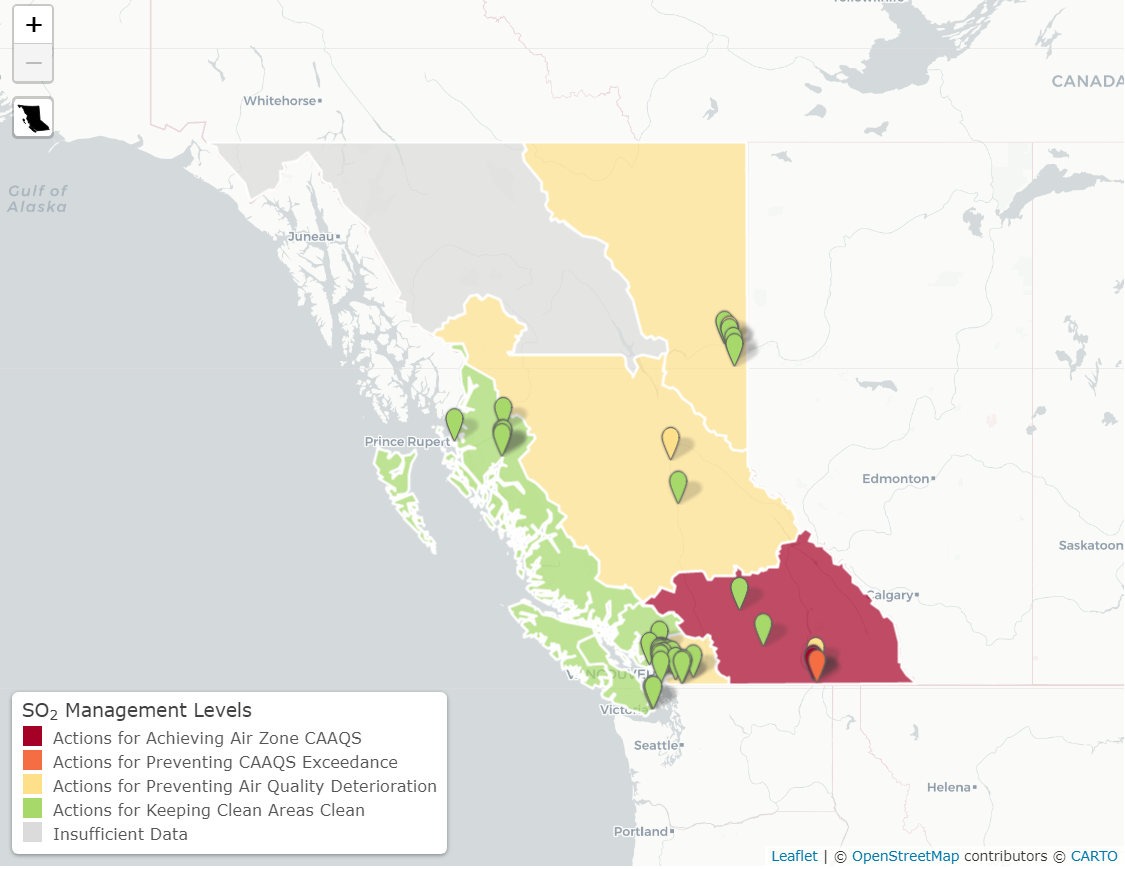Status of Sulphur Dioxide in B.C. (2020-2022)
British Columbia operates a network of air monitoring stations that measure sulphur dioxide and other air pollutants. This indicator reports on the concentration of sulphur dioxide from 2020-2022 and compares it to the Canadian Ambient Air Quality Standards established by the Canadian Council of Ministers of the Environment.
- Sulphur dioxide is a colourless gas with a pungent odour at higher concentrations. The largest sources of SO2 in B.C. include the oil and gas sector, the pulp and paper sector, and metal smelters. Marine vessels and off-road diesel vehicles are additional sources of SO2 (Government of Canada, 2012).
- Sulphur dioxide can be harmful to humans and the environment. Short-term exposure to elevated SO2 can cause difficulties breathing for asthmatics. The long-term impacts of SO2 exposure are not well understood. Increased SO2 in the environment can affect vegetation and aquatic ecosystems through acid rain deposition (Government of Canada, 2012).
The map below summarises the assigned management levels for sulphur dioxide in B.C.'s air zones, as well as the levels of the pollutant at individual monitoring stations. The color of each region refers to the management level. The four management levels are: (1) green (actions for keeping clean areas clean); (2) yellow (actions for preventing air quality deterioration); (3) orange (actions for preventing Canadian Ambient Air Quality Standard exceedance); and (4) red (actions for achieving air zone Canadian Ambient Air Quality Standard). Each management level is associated with a suite of actions that become more rigorous as sulphur dioxide levels approach the standard. More information on Management Levels can be found below. The map shows air quality stations with sufficient data to report for the 2020-2022 reporting period.
Tip: Click or tap on an air zone or monitoring station to see details on the status of sulphur dioxide levels for the 2020-2022 reporting period.
Tip: See Table 6.1 in the Guidance Document on Air Zone Management (CCME, 2019) for more information about the suggested actions for each color/management level in the map below.
Sulphur Dioxide (SO2): Canadian Ambient Air Quality Standard
SO2 levels are calculated using two statistical forms called the annual and the 1-hour metrics. The Canadian Ambient Air Quality Annual Standard for SO2 is achieved when annual levels are 5 parts per billion (ppb) or lower. The 1-hour Standard is achieved when 1-hour levels are 70 ppb or lower.
- Sulphur dioxide levels met both Canadian Ambient Air Quality Standards at 92% of assessed monitoring stations in B.C. There are two standards for SO2: an annual standard and a 1-hour standard (see sidebar). The annual standard was met at 35 of the 38 stations (92%) for which valid data was obtained, while the 1‑hour standard was met at 35 of the 36 stations (97%) with sufficient data for analysis.
- Sulphur dioxide levels met both Canadian Ambient Air Quality Standards in five of B.C.'s seven air zones. The Coastal, Central Interior, Georgia Strait, Northeast, and Lower Fraser Valley air zones met both the SO2 annual and 1-hour standards. The Southern Interior air zone exceeded the 1-hour standard. Currently, there are no air monitoring stations in the Northwest air zone.
What is an Air Zone?
British Columbia is divided into seven air zones. These are areas with similar air quality characteristics, issues, and/or trends.


 Your screen is too small to display the interactive map. Click to see the interactive
visualization in full-screen.
Your screen is too small to display the interactive map. Click to see the interactive
visualization in full-screen.
